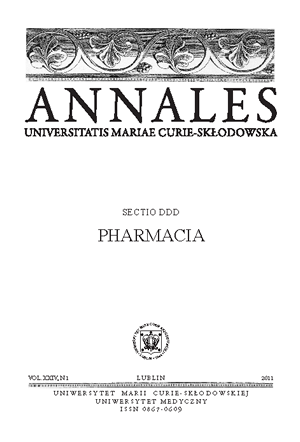Chemical composition and antioxidant activity of the essential oil of hyssop (Hyssopus officinalis L. ssp. officinalis). Part II. Free radical scavenging properties
Keywords:
Hyssopus officinalis L., hyssop, essential oil, DPPH, TLC-DPPH, antioxidant activityAbstract
In the presented work parallel derivatisation with DPPH and Vanlin reagent on the same plate was shown. The investigated sample was essential oil obtained from Hyssopus officinalis L. aerial parts. Parallel derivatisation enabled identification of active, containing antioxidants fraction, which Rf was 0.52. The antioxidant activity of essential oil was examined against the stable free radical DPPH (2,2–diphenyl-1-picrylhydrazyl-hydrate). The antioxidant activity was expressed by using parameter EC50 and also compared with TEAC (Trolox). The results showed that the oil isolated from Hyssopus officinalis L. has low antioxidant activity EC50 value 21.13 mg/ mL and Trolox Equivalent value 0.029 mM.
References
1. Babovic N., Djilas S., Jadranin M. et al.: Supercriticalcarbon dioxide extraction of antioxidant fractions from selected Lamiaceae herbs and their antioxidant capa city. Innov. Food Sci. Emerg. Techn., 11, 98, 2010.
2. Baj T., Kowalski R., Świątek Ł. et al.: Chemical composition and antioxidant activity of the essential oil of hyssop (Hyssopus officinalis L. ssp. officinalis). Annales UMCS, Sect. DDD, 3, 55, 2010.
3. Brand-Williams W., Berset C., Cuvelier M.E.: Use of a Free Radical Method to Evaluate Antioxidant Activity. Lebensm.-Wiss. Technol., 28, 25, 1995.
4. Burfield T.: Safety of essential oils. Int. J. Aromatherapy, 10, 16, 2000.
5. Burkhard P.R., Burkhard K., Haenggeli C.A., Landis T.: Plant-induced seizures: Reappearance of an old problem. J. Neurol., 246, 8, 667, 1999.
6. Cybul M., Nowak R.: Przegląd metod stosowanych w analizie właściwości antyoksydacyjnych wyciągów roślinnych. Herba Pol. 1, 69, 2008. [In Polish]
7. De Vincenzi M., Silano M., Stacchini P., Scazzocchio B.: Constituents of aromatic plats: I. Methyleugenol. Fitoter., 71, 216, 2000.
8. Góra J., Lis A.: Najcenniejsze olejki eteryczne. Wyd. UMK, Toruń, 2004. [In Polish]
9. Gu L., Wu T., Wang Z.: TLC bioautography-guided isolation of antioxidants from fruit of Perilla frutescens var. acuta. Food Sci Techn., 42, 131, 2009.
10. Isman M.B., Wan A.J., Passreiter C. M.: Insecticidal activity of essential oils to the tobacco cutworm, Spodoptera litura. Fitoter., 72, 65, 2001.
11. Marino M., Bersani C., Comi G.: Impedance measurements to study the antimicrobial activity of essential oils from Lamiaceae and Compositae. Int. J. Food Microbiol., 67, 187, 2001.
12. Mazzanti G., Battinelli L., Salvatore G.: Antibacterial properties of the linalol-rich essentials oil of Hyssopus officinalis L. var. decumbens (Lamiaceae). Flavour Fragr. J., 13, 289, 1998.
13. Mimica-Dukić N., Bugarin D., Grabović S. et al.: Essential oil of Myrtus communis L. as a potential antioxidant and antimutagenic agents. Molecules, 15, 2759, 2010.
14. Mensor L.L., Menezes F.S., Leitao G.G. el al.: Screening of Brazilian Plant Extracts for Antioxidant Activity by the Use of DPPH Free Radical Method. Phytother. Res., 15, 127, 2001
15. Nowak R., Gawlik-Dziki U.: Polyphenols of Rosa L. leaves extracts and their Radical Scavening Activity. Z. Naturforsch. C, 62, 32, 2007.
16. Pavela R.: Insecticidal activity of certain medicinal plants. Fitoter., 75, 745, 2004.
17. Piccagalia R., Tammaro F., Pace L.: Characterization of essential oils from three Italian ecotypes of hyssop (Hyssopus officinalis L. subsp. aristatus Gordon Briq.). J. Essent. Oil Res., 11, 693, 1999.
18. Poppenga R.H.: Herbal medicine: potential for intoxication and interactions with conventional drugs. Clin. Techn. Small Anim. Pract., 17, 1, 6, 2002.
19. Tisserand R.: Essential oil safety II. Int. J. Aromatherapy, 7, 4, 26, 1996.
20. Wolski T., Baj T., Kwiatkowski S.: Hyssop (Hyssopus officinalis L.) forgotten medicinal, flavoring and honey-yields plant. Annales UMCS, Sect. DD, 61, 1, 2006.
21. Wolski T., Baj T.: Hyzop lekarski (Hyssopus officinalis L.) – aromatyczna roślina lecznicza. Aromaterapia, 12, 10, 2006. [In Polish]
Downloads
Published
Issue
Section
License
Copyright (c) 2011 Authors

This work is licensed under a Creative Commons Attribution-NonCommercial-NoDerivatives 3.0 Unported License.


